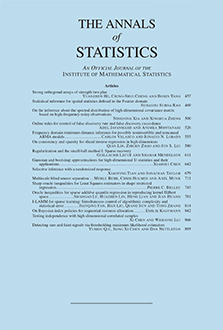Abstract
Motivated by the study of an important data set for understanding the large-scale structure of the universe, this work considers the estimation of the reduced second-moment function, or $K$ function, of a stationary point process on $\mathbb{R}$ observed over a large number of segments of possibly varying lengths. Theory and simulation are used to compare the behavior of isotropic and rigid motion correction estimators and some modifications of these estimators. These results generally support the use of modified versions of the rigid motion correction.When applied to a catalog of astronomical objects known as absorbers, the proposed methods confirm results from earlier analyses of the absorber catalog showing clear evidence of clustering up to $50 h^{-1}$ Mpc and marginal evidence for clustering of matter on spatial scales beyond $100 h^{-1}$ Mpc, which is beyond the distance at which clustering of matter is now generally accepted to exist.
Citation
Ji Meng Loh. Jean M. Quashnock. Michael L. Stein. "Estimating the $K$ function of a point process with an application to cosmology." Ann. Statist. 28 (6) 1503 - 1532, December2000. https://doi.org/10.1214/aos/1015957468
Information





